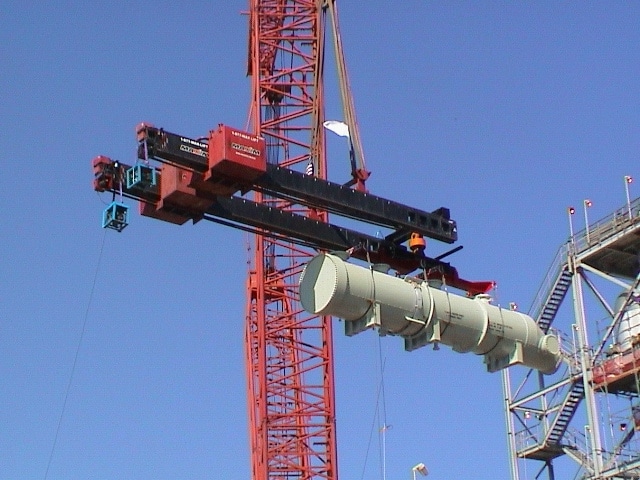Menu
877-MAX-LIFT
(877-629-5438)
Experience the versatility and adaptability of our counter-balance beam rentals. Maxim’s counter-balance beams can make short work of what otherwise would be a highly labor intensive and costly lift. Throughout all industries, Maxim’s clients have found the counter-balance beam as a welcomed cost-effective alternative that reduces down time.

Our Counter-Balance Beam rentals offer a cost-effective solution to a traditional lifting method that requires: facility modifications, significant material costs and man hours and procurement of a rigging contractor. Our solution can manuever your load as if there were no overhead obstructions which is the key to cost reduction. Lifting with Maxim’s counter-balance beams takes relatively no longer than if you had direct crane access.

Our Counter-Balance Beam rentals provide a powerful combination of optimized efficiency and enhanced stability. By utilizing variable amounts of counterweight to offset the load weight, our beams contribute to precise lifting operations. This unique design also contributes to enhanced stability, reducing risks of tipping over.
The customizable configurations and adaptability of our beams set them apart as versatile solutions for a wide range of lifting requirements. Whether you need to lift heavy loads in confined spaces or handle specialized rigging tasks, counter-balance beams can be tailored to meet your specific project needs. By the nature of our beam design, project specification and modifications are virtually limitless.

Ideal for a wide range of heavy lifting tasks, our beams offer versatility and stability, making them a valuable asset for various applications. Whether you’re working on construction projects, industrial maintenance, or rigging operations, renting our counter-balance beams allows you to achieve precision and efficiency in lifting operations. With their adaptable configurations and ability to offset load weights effectively, our beams provide a cost-effective solution for streamlining your lifting tasks and optimizing project workflows. Experience improved lifting processes with our innovative counter-balance beam rentals, tailored to meet your unique project requirements.
Begin by filling out our online form or contacting us via phone to provide essential details such as load capacity, reach requirements, and project duration. We will then generate a personalized rental quote tailored to your project’s specific needs and budget.
After working with our team of engineers to develop a work plan that aligns with your project requirements, budget, and timeline, secure the counter-balance beam for your project.
Throughout your project’s duration, benefit from our unwavering commitment to continuous support. From project initiation to completion, our team offers round-the-clock assistance and ensures a prompt response to any questions or concerns you may have.
A counter-balance beam is a below the hook (BTH) device that helps to balance the weight of the load being lifted. The counter-balance beam has movable variable counterweights to keep the load level and reduce the amount of man-hours required to complete work.
The counter weights can be positioned along the sides of the Beam and or suspended from beneath. Rigging ports can be fitted with trunions or structural beams and lift bails to accommodate rigging to most any size or shape of lift. Swivel links can be used should the lift require rotation. By the nature of its design, project specific modifications are virtually limitless.
Counter-Balance Beams outshine traditional methods by offering unparalleled efficiency and cost savings. Unlike cumbersome approaches involving Structural and Civil Engineering, extensive modifications, and the need for rigging contractors, our crane beams provide a seamless solution that minimizes overhead obstructions and reduces costs. Additionally, while traditional methods such as bull-rigging or jacking & sliding lead to downtime and production delays, utilizing our Counter-Balance Beams contribute to swift lifts, minimal disruption, and optimal productivity.
The advantages of a counter-balance beam include direct cost savings by avoiding the need for structural modifications and professional rigging contractors and may reduced client outage and downtime compared to traditional methods, fewer required man-hours, adaptability to accommodate various sizes and shapes of lifts, and various configurations to meet project logistics and lift capacities. Overall, the counter-balance beam offers a cost-effective and efficient solution.
(877-629-5438)
(877-629-5438)
Maxim Crane is a coast-to-coast crane rental company specializing in crane rental and lifting services.
All Media inquiries should be made to the Maxim Crane Works Media Inquiry Hotline at 412-500-9029.
(877-629-5438)
Across the United States
Find the right equipment
See our inventory of used equipment.
